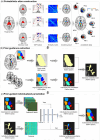Prior-guided individualized thalamic parcellation based on local diffusion characteristics
- PMID: 38433705
- PMCID: PMC10910286
- DOI: 10.1002/hbm.26646
Prior-guided individualized thalamic parcellation based on local diffusion characteristics
Abstract
Comprising numerous subnuclei, the thalamus intricately interconnects the cortex and subcortex, orchestrating various facets of brain functions. Extracting personalized parcellation patterns for these subnuclei is crucial, as different thalamic nuclei play varying roles in cognition and serve as therapeutic targets for neuromodulation. However, accurately delineating the thalamic nuclei boundary at the individual level is challenging due to intersubject variability. In this study, we proposed a prior-guided parcellation (PG-par) method to achieve robust individualized thalamic parcellation based on a central-boundary prior. We first constructed probabilistic atlas of thalamic nuclei using high-quality diffusion MRI datasets based on the local diffusion characteristics. Subsequently, high-probability voxels in the probabilistic atlas were utilized as prior guidance to train unique multiple classification models for each subject based on a multilayer perceptron. Finally, we employed the trained model to predict the parcellation labels for thalamic voxels and construct individualized thalamic parcellation. Through a test-retest assessment, the proposed prior-guided individualized thalamic parcellation exhibited excellent reproducibility and the capacity to detect individual variability. Compared with group atlas registration and individual clustering parcellation, the proposed PG-par demonstrated superior parcellation performance under different scanning protocols and clinic settings. Furthermore, the prior-guided individualized parcellation exhibited better correspondence with the histological staining atlas. The proposed prior-guided individualized thalamic parcellation method contributes to the personalized modeling of brain parcellation.
Keywords: diffusion MRI; individualized brain mapping; machine learning; orientation distribution function; thalamic parcellation.
© 2024 The Authors. Human Brain Mapping published by Wiley Periodicals LLC.
Conflict of interest statement
The authors declare that the research was conducted without any commercial or financial relationships that could be construed as a potential conflict of interest.
Figures






Similar articles
-
Iterative prior-guided parcellation (iPGP) for capturing inter-subject and inter-nuclei variability in thalamic mapping.Neuroimage. 2025 Jul 25;318:121399. doi: 10.1016/j.neuroimage.2025.121399. Online ahead of print. Neuroimage. 2025. PMID: 40714230
-
In-vivo probabilistic atlas of human thalamic nuclei based on diffusion- weighted magnetic resonance imaging.Sci Data. 2018 Nov 27;5:180270. doi: 10.1038/sdata.2018.270. Sci Data. 2018. PMID: 30480664 Free PMC article.
-
Probabilistic tractography-based thalamic parcellation in healthy newborns and newborns with congenital heart disease.J Magn Reson Imaging. 2018 Jun;47(6):1626-1637. doi: 10.1002/jmri.25875. Epub 2017 Oct 28. J Magn Reson Imaging. 2018. PMID: 29080379 Free PMC article.
-
Mapping the primate thalamus: historical perspective and modern approaches for defining nuclei.Brain Struct Funct. 2023 Jun;228(5):1125-1151. doi: 10.1007/s00429-022-02598-4. Epub 2023 Jan 9. Brain Struct Funct. 2023. PMID: 36622414 Free PMC article. Review.
-
An exemplar-based approach to individualized parcellation reveals the need for sex specific functional networks.Neuroimage. 2018 Apr 15;170:54-67. doi: 10.1016/j.neuroimage.2017.08.068. Epub 2017 Sep 5. Neuroimage. 2018. PMID: 28882628 Free PMC article. Review.
Cited by
-
Revolutionizing treatment for disorders of consciousness: a multidisciplinary review of advancements in deep brain stimulation.Mil Med Res. 2024 Dec 18;11(1):81. doi: 10.1186/s40779-024-00585-w. Mil Med Res. 2024. PMID: 39690407 Free PMC article. Review.
References
-
- Baldermann, J. C. , Kuhn, J. , Schuller, T. , Kohl, S. , Andrade, P. , Schleyken, S. , Prinz‐Langenohl, R. , Hellmich, M. , Barbe, M. T. , Timmermann, L. , Visser‐Vandewalle, V. , & Huys, D. (2021). Thalamic deep brain stimulation for Tourette syndrome: A naturalistic trial with brief randomized, double‐blinded sham‐controlled periods. Brain Stimulation, 14(5), 1059–1067. 10.1016/j.brs.2021.07.003 - DOI - PubMed
-
- Basile, G. A. , Quartu, M. , Bertino, S. , Serra, M. P. , Trucas, M. , Boi, M. , Demontis, R. , Bramanti, A. , Anastasi, G. P. , Milardi, D. , Ciurleo, R. , & Cacciola, A. (2022). In vivo probabilistic atlas of white matter tracts of the human subthalamic area combining track density imaging and optimized diffusion tractography. Brain Structure and Function, 227(8), 2647–2665. 10.1007/s00429-022-02561-3 - DOI - PMC - PubMed
-
- Battistella, G. , Najdenovska, E. , Maeder, P. , Ghazaleh, N. , Daducci, A. , Thiran, J. P. , Jacquemont, S. , Tuleasca, C. , Levivier, M. , Bach Cuadra, M. , & Fornari, E. (2017). Robust thalamic nuclei segmentation method based on local diffusion magnetic resonance properties. Brain Structure and Function, 222(5), 2203–2216. 10.1007/s00429-016-1336-4 - DOI - PMC - PubMed
MeSH terms
Grants and funding
- XDB32030200/Strategic Priority Research Program of Chinese Academy of Sciences
- 2017YFA0105203/National Key R&D Program of China
- Youth Innovation Promotion Association
- Beijing Advanced Discipline Fund
- 2021ZD0200203/Science and Technology Innovation 2030 - Brain Science and Brain-Inspired Intelligence Project of China
LinkOut - more resources
Full Text Sources

